The NVIDIA SHIELD Android TV Review: A Premium 4K Set Top Box
by Ganesh T S on May 28, 2015 3:00 PM EST- Posted in
- Media Streamer
- Home Theater
- TV
- 4K
- Shield
- NVIDIA
Graphics Performance
While the SHIELD Android TV and the underlying Tegra X1 SoC are by no means slouches on the CPU side of matters, ultimately NVIDIA is still just another ARM Cortex implementer. On the other hand when it comes to GPUs, this is where NVIDIA truly shines. As NVIDIA is first and foremost a GPU company, and as a design philosophy always invests more time and die space into GPUs than any other SoC builder (save perhaps Apple X-class SoCs), they have always led the pack on GPU performance. And with the Tegra X1 packing a 256 CUDA core implementation of the very potent Maxwell GPU architecture, an estimated 1GHz clockspeed, and all the power and cooling it needs to keep from throttling, all of the ingredients are in place for a very strong showing from NVIDIA for GPU performance.
If there’s any real downside for NVIDIA and the SHIELD Android TV here, it’s that the Android GPU benchmarking situation hasn’t really caught up with what their GPUs are capable of. The standard benchmarks work, but game benchmarks are virtually non-existent, even in the AA and AAA games NVIDIA has helped bring over to the Android/SHIELD ecosystem. So we can’t for example look at the performance of The Talos Principle in the same way as we can the PC today.
Anyhow, we’ll start off with 3DMark’s Ice Storm Unlimited benchmark.
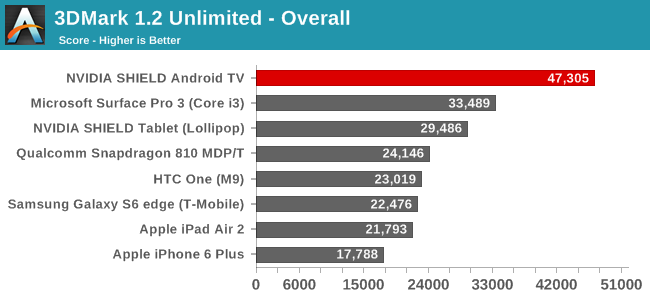
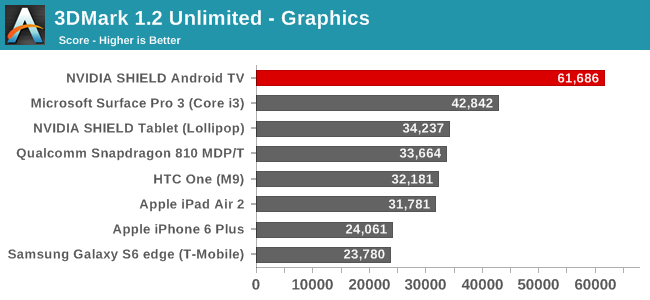
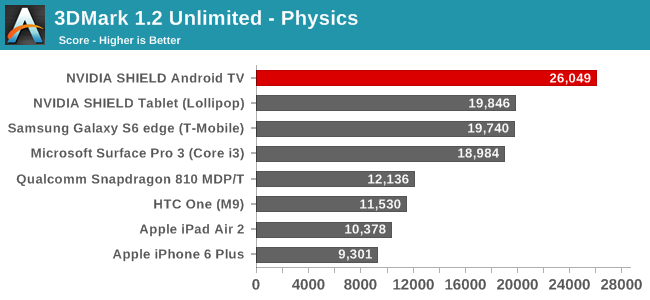
The results here pretty much speak for themselves, especially in the all-GPU graphics sub-score. SHIELD Android TV is 50% faster than the Surface Pro 3 and almost twice as fast as other devices like the iPad Air 2 and the last-generation SHIELD Tablet. Graphics workloads tend to be the most punishing from a heat and power standpoint, and hence are the most likely to get throttled. This really lets the SHIELD and its SoC open up here. At the same time, even in the physics score and the composite overall score, the SHIELD is well in the lead thanks to this combination of factors.
Up next we have BaseMark X 1.1.
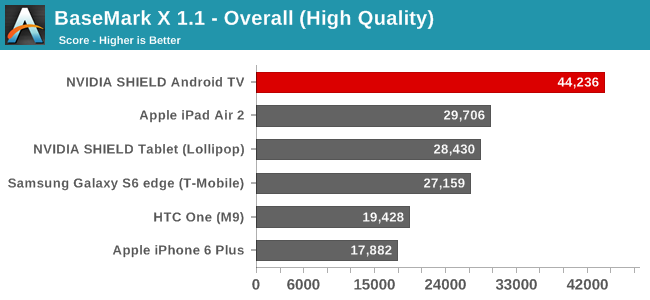
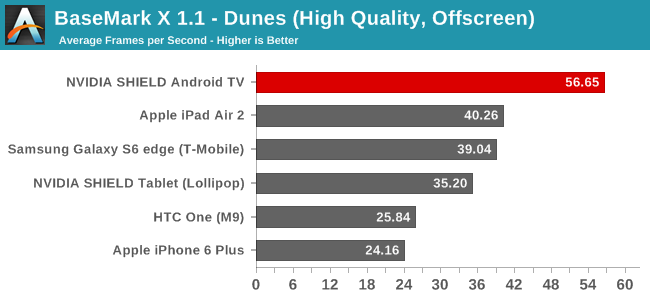

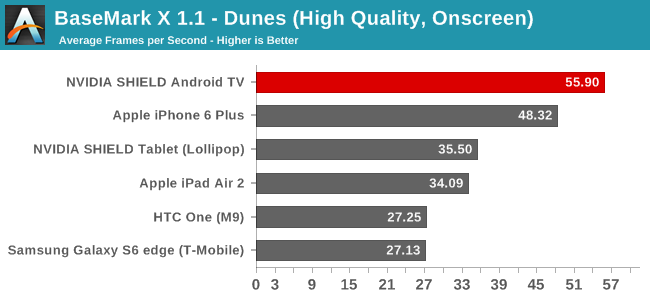
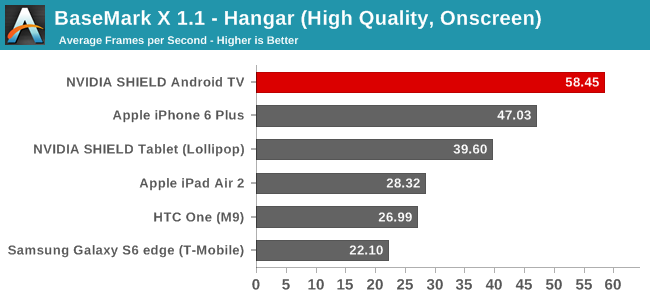
Once more it’s a clean sweep for the SHIELD. Apple’s iPad Air 2 tends to be the second-place finisher, thanks to Apple’s own significant investment in GPU resources, the SHIELD gets yet more resources and the power to fully exploit them. With all of that said, the one thing that does surprise me a bit here is that even the SHIELD can’t crack 60fps on Dunes and Hangar; BaseMark X will likely take one more generation before its tests can be completely beaten.
Our final GPU benchmark is GFXBench.

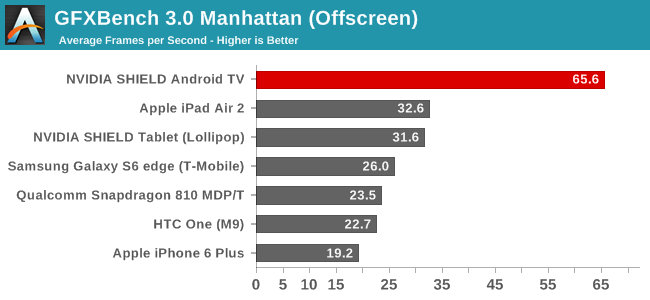
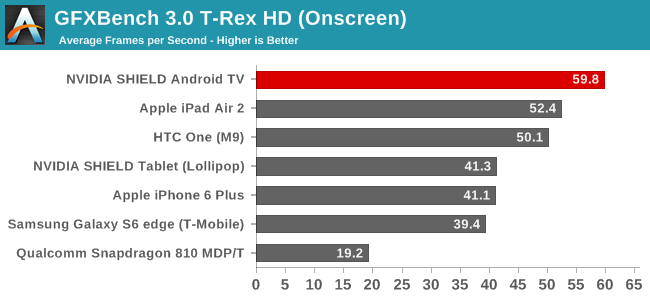
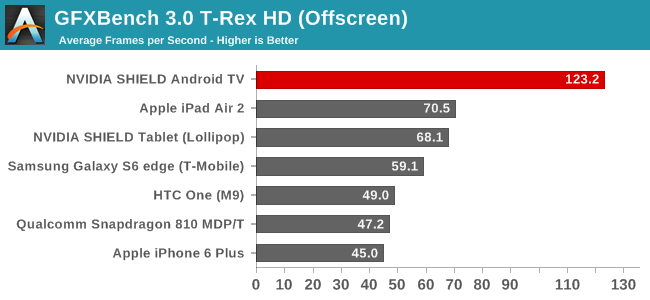
Starting first with the benchmark’s high-level tests, we once again find the SHIELD well in the lead. Of particular note here, the SHIELD Android TV becomes the first Android device to break 60fps on Manhattan, something that as recently as a generation ago seemed impossibly far away.
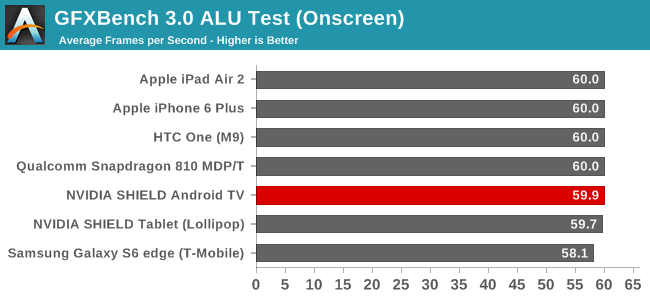
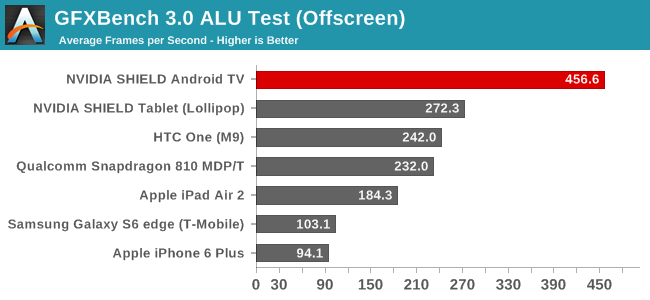

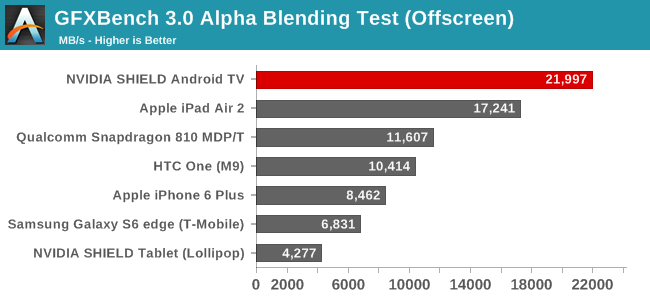
The low-level tests meanwhile offer us an interesting look at SHIELD and Tegra X1 that the high-level tests don’t provide. The ALU test for example drives home the point of just how much in the way of shading resources Tegra X1 has at its disposal (at least when unrestricted), and is a big reason why the SHIELD is doing so well here. On the other hand while NVIDIA still takes the top spot in alpha blending, the lead over the iPad Air 2 isn’t nearly as great, thanks in large part to the iPad’s relatively large 128-bit memory bus. Ultimately SHIELD doesn’t struggle here, but it’s an interesting point of comparison since it shows one of the only cases where SHIELD isn’t a run-away winner, and what kind of graphics workload may eat into its otherwise ridiculous advantage.
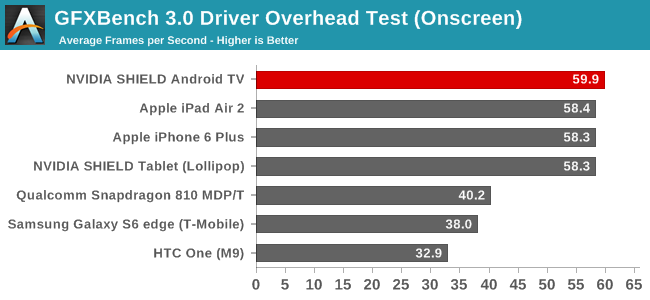
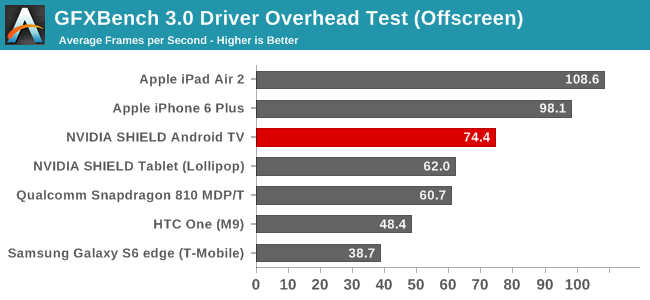
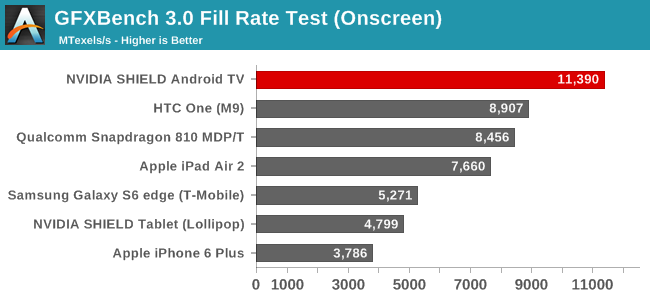
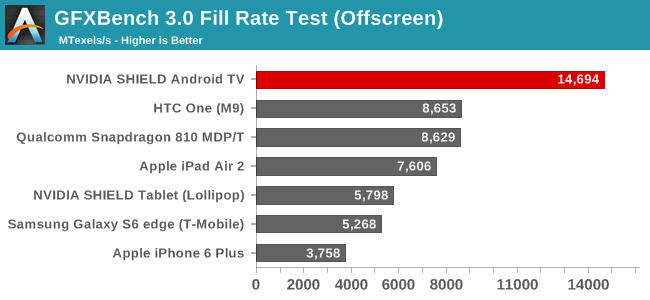
On the last batch of subtests, I’m going to stop again with the fill rate test just to point out another interesting design decision for Tegra X1 and the SHIELD. With NVIDIA banking so much on the set top box’s ability to drive 4Kp60 TVs, NVIDIA needs to push a lot of pixels to get there, as 4K is four-times as many pixels as 1080p. For this reason Tegra X1 is paired with 16 ROPs, giving it low-end PC desktop-like pixel throughput, and of course a huge advantage in the GFXBench fill rate test. And though this fill rate will help with games as well, it’s keeping up with the Android UI at 4Kp60 that is the most important reason for all of this fill rate performance.
Wrapping things up, what else is there to say about the SHIELD Android TV’s GPU performance? What we’re looking at here is twice as fast (or more) than the best phones and tablets today, a combination of the Tegra X1’s very strong GPU design and the set top’s practically unlimited energy and cooling capabilities. Overall NVIDIA is following the path they started long ago on Tegra, always favoring strong GPU performance, leading to the incredible performance we’re seeing here.
With that said, given NVIDIA’s decision to focus on the Android TV aspects of the SHIELD Android TV first and foremost – and not gaming – it’s also fair to say that the SHIELD is overpowered for Android TV work. Other than keeping up with the basic pixel fill needs of 4K, the real power of the box’s GPU is going to be left untapped by Android TV (especially on the ALU side). Which makes all of this humorously absurd in a way, but it’s also why SHIELD Android TV isn’t just an Android TV box. The device’s GPU performance will be put to good use with gaming, though stepping outside the world of benchmarks for a second, the bigger challenge NVIDIA faces is not delivering high performance, it’s delivering games that make full use of that performance.










167 Comments
View All Comments
BrokenCrayons - Friday, May 29, 2015 - link
Tablets with Windows 8.1 are very nice, inexpensive devices that can play videos and do a lot of other useful things, including running the usual library of x86 Windows software. While I think it's nice that nv is working on stuff like this, it just doesn't compete at all in flexibility with even something like a HP Stream desktop (the cute little blue tupperware-looking PC they sell for about the same price as this thing). Okay, okay, so you can display stuff on a 4k screen, but those aren't common and a lot of people, myself included, don't even own an external screen and would never consider buying one because they don't want to be stuck in one place passively consuming pre-recorded media. That seems like such an obsolete concept.Yojimbo - Friday, May 29, 2015 - link
You either have a lot of extra money or live alone. What happens to the TV when you take the tablet away? Why pay for a screen, camera, battery, and shock resistance, etc., or deal with power throttling when you don't have to? Any tablet that can do what the Shield TV can do is going to cost a lot more than the Shield TV. Plus the Shield TV doesn't look like someone left a tablet lying around. This is selling for $200 with a controller. The Shield Tablet cost $300 without a controller and with less I/O connectivity.savagemike - Friday, May 29, 2015 - link
It also won't toast bread - which my toaster does just fine. So I too don't see the point.TheJian - Friday, May 29, 2015 - link
Not sure why this can't replace your HTPC when you can load OTHER players that can do the things you call shortcomings of the built-in player (like kodi, VLC, Powerdvd's android app). It seems to me you should be able to get around any shortcomings with other apps.I see you said VLC doesn't work that well on shield right now (what do you mean by this comment ?), but what about running something like powerdvd from the PC as noted to get around issues? The android app will accept streaming from local PC's running PowerDVD which plays everything this won't I think. Most people even pondering an HTPC already have a full PC in another room on the network so any shortcomings here should be covered by that I'd guess (including playing blurays etc).
Why wasn't the Intel device shown in more stuff? IE, gfxbench, pcmark, Basemark 2? IE why not thrown in the surface 3 for these which you already have the scores for?
http://www.anandtech.com/show/9219/the-surface-3-r...
Saves me from bouncing back and forth to see how badly Intel got killed ;) You had surface 3 pro scores too as shown, why leave them out? Manhattan offscreen 1080p shows Surface 3 pro at 29fps, why not include it when you already have those scores? You had PCmark scores for Surface3 pro also shown above. Are the work portions completely different? Are the other pcmark tests not able to run on surface 3 pro? Photo editing/video playback etc PCMark benchmarks don't work on them? You had all the gfxbench scores for both surface3 pro and regular also. I don't get why you put them in for some stuff, but exclude listing those in other tests when you had the data.
daggre - Friday, May 29, 2015 - link
1. It's too expensive. It needs to be $99 like the Apple TV was before they dropped the price to $69. I know that's a huge drop and it may not be possible with the current specs (yet) but it won't ever be successful if it's more than $100.2. It needs to play all Android games, and then play Android TV games really really well. It may already do this but it wasn't clear from the article. Any games nVidia makes should be for Android TV in general (i.e. "Controllers instead of touch") but should really shine on Shield. If anyone plays a game on a different Android TV they should say to themselves "I wish I had bought a Shield" so then those games become both guides to other developers of what their Android TV games should be like, but also become advertisements to gamers on any Android device that the game they are playing on their phone/tablet/other Android TV hardware would be a better experience on the Shield.
In the end, if they don't have really good 3rd party support this will fail. Only Apple is capable of pulling a success out of the air (Apple TV) without 3rd party offerings, and even they had to open up to Netflix, Hulu, HBO and the sports channels.
malooka - Saturday, May 30, 2015 - link
The Matricom MX2 Midnight is about 79.00 You can get a fly mote (like a Wii remote) it has two partitions one side for internet and gaming and the other side for KODI They have a newer versioin out but I like my model which is a little cheaper. The xbmx which is now KODI is the streaming side. I love this box. You can find it on amazon. http://www.amazon.com/s/ref=nb_sb_ss_sc_7_14?url=s...bernstein - Friday, May 29, 2015 - link
Seems a bit like a missed opportunity...- no HD bitstreaming, no legacy hardware decoding...
- pairing a GTX960 class GPU (8 SMM instead of two) with an octo-core A57 might feasible for a $300-350 price point. Especially if it could dualboot steam os...
hifiaudio2 - Friday, May 29, 2015 - link
It is being said that Nvidia is considering a Codec pack to add HD audio passthrough, VC-1, Mpeg2, etc in hardware.It was also said that Mpeg2 hardware is already on the device, but currently only activated when installing a program like the forthcoming Silicondust HDHomerun DVR program that just had a Kickstarter and will come out in a few months (alpha testing to start in June for the Kickstarter backers).
Go the the Nvidia forums and voice your opinion for the Codec to be released!!!
https://forums.geforce.com/default/topic/836487/sh...
douglord - Friday, May 29, 2015 - link
GGames - You say this has 10-bit color output and HDR capability. Do any consumer grade dGPUs have that (along with the HDMI 2.0a and HDCP needs). I'm really concerned about this for my next PC build. Any thought on how to build a UHD Blueray capable 4k HTPC?ganeshts - Saturday, May 30, 2015 - link
GTX 960 is your only option right now.Wait for a few more months.. other options should start coming out